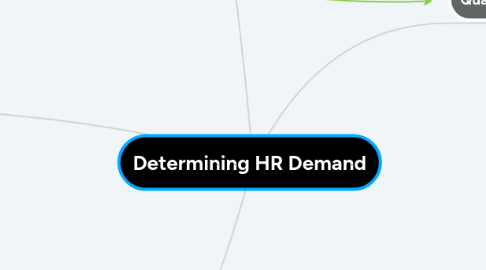
1. Time Series Models
1.1. Use past data to predict the future demand
1.2. Range from very simple to highly complex
1.3. Weighted moving average - places more importance on recent demand data
1.4. Analysis usually incorporates only the relationship between a single business variable and demand for labour
2. The Importance of Forecasting
2.1. HR demand refers to the future need for the firm's skills and requirements
2.2. understanding the demand begins with the firm's strategy
2.2.1. How doe the firm bring value to the customer?
2.2.2. Estimate which products and services of the firm will be consumed by the market
2.3. Two existing methods to forecast the demand for labour: Qualitative and Quantitative
2.3.1. Quantitative models are not the best for future needs if business and environment is in significant transition
2.3.2. Qualitative Forecasting
2.3.2.1. Used when great deal of uncertainty
2.3.2.2. Direct managerial input is most commonly used method for determining workforce requirements
2.3.2.3. Use experts to arrive at numerical estimates for future labour demand
2.3.2.4. Wide variety of individuals may be considered experts in their knowledge of organizational operations, HR practices, internal trends and labour market
3. Quantitative Methods
3.1. Trend Analysis
3.1.1. Forecasting method that attempts to forecast future personnel needs by extrapolating from historical change in one or more organizational indices
3.2. Ratio Analysis
3.2.1. Method of projecting HR demand by analyzing the relationship between operation index and the number of employees required
3.3. Big Data
3.3.1. HR departments have several stand-alone data management systems - HRIS
3.3.2. Refers to the integration of digitalized data from all the corporate functions
3.3.3. Big Data gets bigger all the time - doubling every 2 years
3.4. Regression Analysis
3.4.1. A linear relationship that exists between one or more independent variable, which are predicted to affect the dependent variable (HR demand personnel)
3.4.1.1. Example: number of employees
3.4.2. Able to predict enough variability in the outcome variable with a trend line, then trend line can be used to extrapolate beyond the data and create a forecast
3.4.2.1. Example: predicting the number of employees who will be required as sales revenues increase
3.4.3. Slope of the line - represents the amount of variability in the criterion that can be described by the independent variable
3.4.4. Limitations - is good a predicting linear relationships, but unreliable and misleading for predictions when relationships are non-linear
3.4.4.1. Not ideal forecasting method for highly unstable markets
3.4.4.2. Require Sufficient amount of historical data
4. Qualitative Methods
4.1. Scenario Planning
4.1.1. Method often used to develop organizational strategy
4.1.2. Primary strength - encourages participants to develop strongly shared mental models of future organizational states
4.1.3. Method for imagining future possible conditions in which the organization might operate
4.1.4. Benefit - really is no limit to the number of possible scenarios that the future could hold; allows planning to understand the most important assumptions
4.1.5. Ex. Establish staffing tables, pessimistic or realistic scenarios
4.2. Delphi Technique
4.2.1. A process in which the forecasts and judgments of a selected group of experts are solicited and summarized in an attempt to determine the future HR demand
4.2.2. Key Feature - once a group of experts is selected they do not meet face to face
4.2.3. Advantage - it avoids many problems associated with face to face group.
4.2.3.1. Examples: Shyness, perceived lower status authority, perceived communication deficiencies, issues of individual dominance and groupthink
4.2.4. Elicits feedback from all expert members
4.2.5. Disadvantage - the time and costs incurred are higher than other alternative techniques
4.2.6. 6 Steps to Delphi Technique
4.2.6.1. 1. Define and Refine the issue or question
4.2.6.2. 2. Identify the experts, terms and the horizon
4.2.6.3. 3. Orient the experts
4.2.6.4. 4. Issue the first round of questionnaires'
4.2.6.5. 5. Issue the first round of questionares summary and the second round of questionaire
4.2.6.6. 6. Continue issuing questionarires
4.3. Nominal Group Technique
4.3.1. Long run forecasting technique utilizing expert assessments
4.3.2. Group meets face to face
4.3.3. Each demand estimate is considered to be the property of the entire group
4.3.4. Primary advantage - allows all participants to continue to process at equal levels
4.3.5. Expert forecast is determined by a secret vote of all group members on their choice of table demand forecasts
4.3.6. Steps for Nominal Group Technique
4.3.6.1. 1. Define and Refine the issue or question and the relevant time horizon
4.3.6.2. 2. Select the experts
4.3.6.3. 3. Issue the HR demand statement to the experts
4.3.6.4. 4. Apply expert knowledge, state assumptions and prepare an estimate
4.3.6.5. 5. Meet face to face
4.3.6.6. 6. Discuss the demand estimates and assumptions
4.3.6.7. 7. Vote secretly to determine the expert demand assessment
4.4. HR Budgets/Staffing Tables
4.4.1. Operational or short run demand estimates that contain a number of types of personnel required by the organization as a whole and for each subunit, division or department
4.4.2. Take into consideration of historical staffing trends
4.4.3. HR budget produces a staffing table which is the total HR demand requirement for operational or short run time periods
